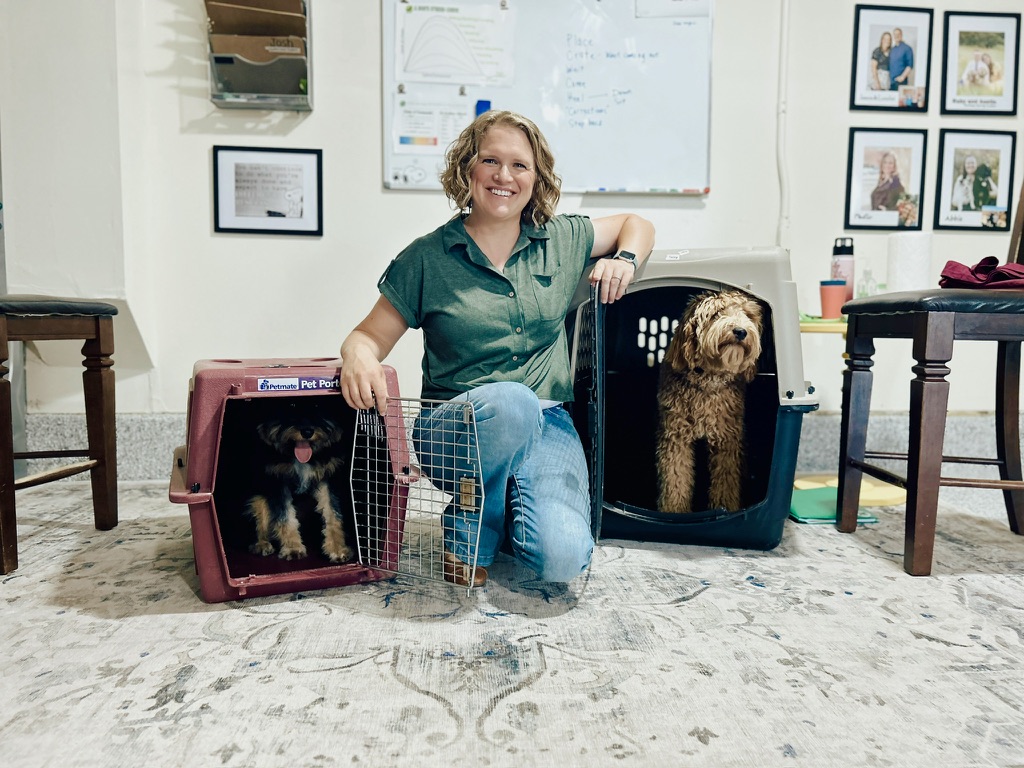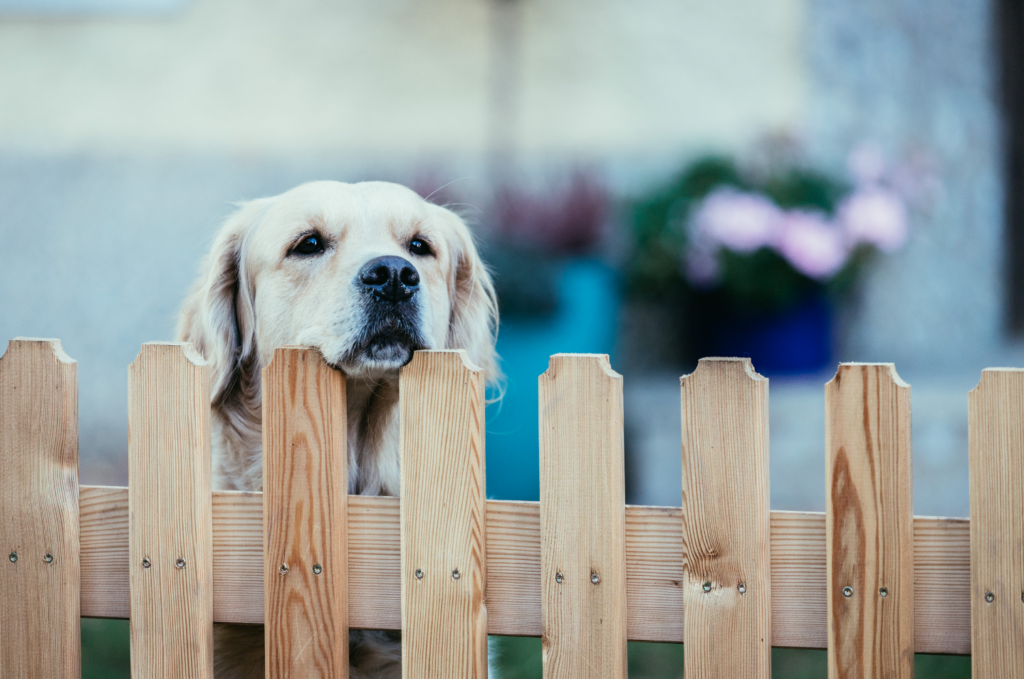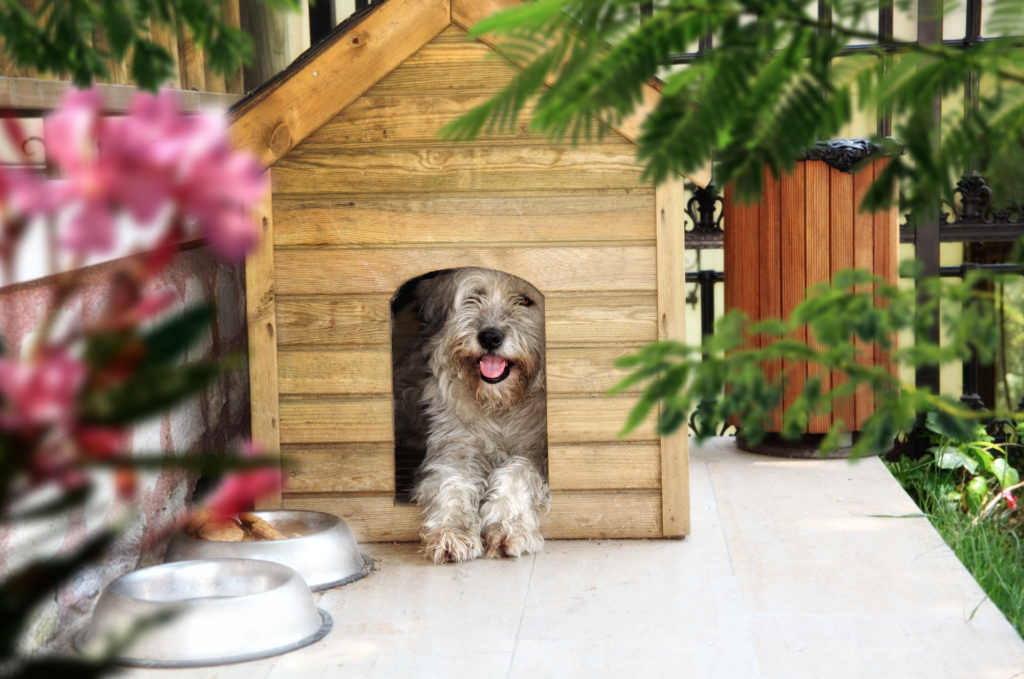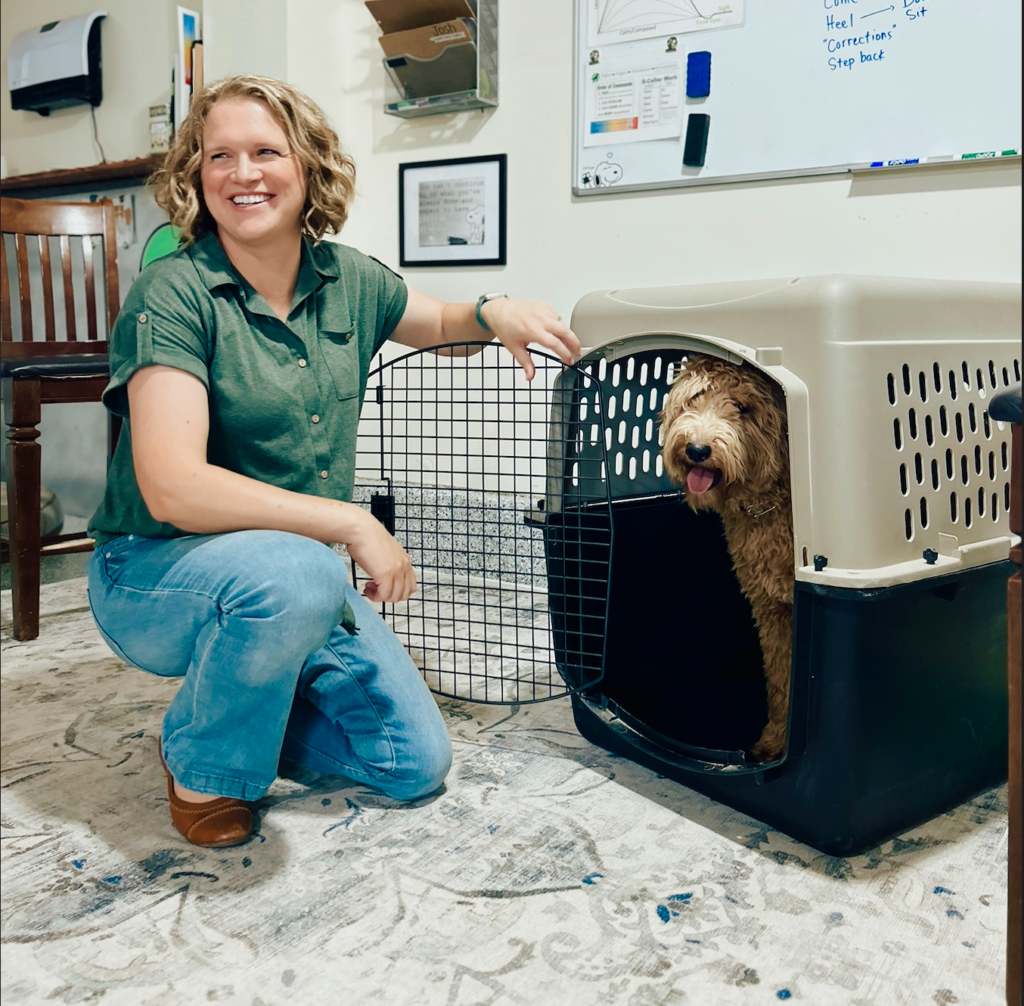Kennels, Crates, Dog Runs, and Play Pens can all have their appropriate and helpful use in training your dog, but some of these tools are WAY more useful than others. These words are often used interchangably, making their meanings confusing. Let’s clear up the meaning of each and then, more importantly, the best use of each tool while training your dog.
First, let’s clear up the vernacular.
Definition of Kennel, Crate, Dog Run, and Dog Play Pen
- Kennels: An Outdoor Safe Space

Outdoor structures, commonly known as dog kennels or dog houses, are designed to provide a secure and sheltered space for dogs. Unlike crates, which people usually use indoors and are smaller in size, kennels offer more space and are designed to accommodate larger breeds, multiple dogs, or to serve as a closely monitored outdoor living space.
- Crates: A Cozy Indoor Retreat and Invaluable Training Tool

Crates, sometimes known as dog crates or kennels, are indoor enclosures designed to provide a secure and comfortable space for dogs. Crates are invaluable tools in various aspects of dog training, including potty training, behavior modification, and travel.
- Dog Runs: Fostering Outdoor Freedom (But Can Be Detrimental to Training)

Dog runs, also known as dog pens or exercise pens, are outdoor enclosures that allow dogs to have more freedom of movement than a kennel (although that’s not always as good for the dog as it sounds). They are typically larger than crates and provide a secure space for dogs to play, exercise, and explore outdoors. If you’re not careful, though, the use of a dog run can hurt your training efforts. But more on that later.
- Play Pens: Flexible Indoor Play Areas
Play pens, also known as puppy play pens or exercise pens, are indoor enclosures designed to provide a safe and controlled space for puppies or smaller breeds to play and explore. Play pens are versatile and can be easily adjusted to accommodate different sizes and configurations. Although play pens can be used well as a training tool, they most often are simply not needed once you start a solid training program.
Why definitions matter

We discovered there is confusion around the meaning of these terms when we were talking with our digital courses coach who lives in Oklahoma. She was confused about our “14-Day Kennel Training Challenge.” When she thought of the word kennel, she thought of a place where you bring your dog to be boarded either just for the day or overnight. But what we were actually talking about was a smaller indoor plastic or metal enclosure just big enough for one dog (AKA a “crate” as defined earlier).
After Jason and I continued to research, we found that was true across most of the United States and a better term for what we were referring to was “Crate.” We in the Western United States were the odd ones. So we changed the name of the course to be “14-Day Crate and Potty Training.”
Being clear on meanings of words is important so we all are on the same page. Jason has a funny story about this very thing from when he was translating from German to English for a group of people and messed up an entire story because he misunderstood one word. He shares the story in his podcast #65 “Crate or Kennel?” It’s a fun listen. I’ll link it below.
What’s a Good Training Tool and What’s NOT?
Dog Training Using a Kennel
When defining kennels as an outdoor enclosed space, these spaces are generally NOT a good training tool. It’s really more of a management tool to keep your dog secure and safe outside. But rarely do people use it as a way to teach or modify a behavior. We have never used one that way in our training programs.
The use of a kennel does NOT replace the need to crate train your dog.
Kennels are not a bad thing, though, if used correctly.
For example, my brother and his family live in a very rural town in central Utah. They have an awesome lab named Bolt that lives outdoors 95% of the time. They created an outdoor fenced in area right next to their backdoor that is about 8 feet by 8 feet and also contains his dog house. It works well for them and provides a place to securely have their dog during certain times of the day. Plus Bolt has no behavior problems while in the kennel.

The appropriate time to possibly use a kennel would be AFTER completing a training program and being happy with your dog’s obedience, relationship with you, and mental health. Then as you slowly incorporate an outdoor kennel, supervise a lot at first to ensure no bad behaviors creep in.
Remember, though, the use of a kennel does NOT replace the need to crate train your dog! Next, I’ll explain why that is.
Dog Training Using a Crate
The crate is your #1 most valuable training tool! And I really mean that. It is #1! As much as I love and appreciate every other tool we use in our training programs (a slip lead, food pouch, and place mat for puppies and additionally an ecollar and prong collar with older dogs), I would still choose the crate as my #1.
Perhaps you are like me when I first got a dog. I had so much guilt around putting a dog in the crate. It felt like I was putting my dog in a jail cell. It broke my mother-heart. I go into this story and my journey to understanding crate training within our Crate and Potty Training Course, but ultimately I had to learn that dogs are not humans and they function differently.

How Dogs Perceive a Crate
Dogs are den animals and can find a lot of peace and protection from using a crate daily, even at intervals throughout the day. They like it. But at first, it may take some coaching from us to teach them to find that peaceful space in their mind while in the crate. The crate becomes a space for your dog to decompress. We could all use a space to decompress, don’t you think?
It’s almost like a person first learning to meditate or pray. It may be a bit uncomfortable at first, but eventually with practice and coaching, it can become such a beautiful part of your life.
The same is true when crate training your dog. And if your dog struggles with the crate, I can promise that if you jump into our “14-Day Crate and Potty Training” course, you will see huge improvements within just a few days!
Plus, as the name of our course implies, the crate is also your #1 potty training tool. Really! I can’t imagine potty training any age of dog without the use of the crate! And guaranteed I’ve potty trained more dogs than your average human.
Dog Training Using a Dog Run
A dog run is not a bad tool, but here’s the kicker…a dog run can be detrimental to training if you never provide your dog with MENTAL exercise. You can’t just throw them in a dog run and expect that all this freedom and space will be enough mental and physical stimulation.
Same goes for letting your dog just hang out in your backyard all day.
People come to us complaining that they have provided their dog with all this outdoor space and freedom to exercise and explore and their dog is still hyper and crazy or anxious and uptight. If your dog is having behavior problems, we promise that giving your dog MORE space and MORE freedom is not going to help.
Jason and I often say, “Grant freedom as it is earned.”
So if you’re having behavior problems, pull back and give your dog less space and tighter boundaries. Not because you’re mean, but because you’re a responsible and loving dog owner. Another way to think of it is to reduce the things your dog has to worry about or be distracted by, all while providing clearer direction through positive mental exercises for them to focus on.
If you want exact direction on what those boundaries should be and how to communicate them to your dog, check out our Chaos to Calm Training Course. Or if you have a puppy younger than 5 months, jump into our Puppy Training Course. You’ll know exactly what to do week by week to build the dog of your dreams!
How to Fix Bad Behavior in the Dog Run
Often when bad behavior happens in this outdoor space, no feedback is given to the dog so the problems persists or even worsens. We see that a lot with people who come to us for training. The dog is loosing their minds out there, barking at anything that moves, digging holes, or chewing everything in sight and no one is there to correct them or give the dog a positive task to use with all their mental stored up energy.
If you truly want to make use of an outdoor dog run (and not just use it as a way to escape from your dog’s behavior problems), go through a training program first and make sure you and your dog are in a good space first. Ensure your dog has boundaries, obedience, and good mental health before introducing a dog run.
At that point, you can slowly introduce leaving your dog alone in the dog run area. Just be sure that the first couple weeks of using it, you’re monitoring more to teach appropriate behaviors while in the dog run.
Dog Training Using a Play Pen
A play pen is an indoor enclosures designed to provide a safe and controlled space for puppies or smaller breeds to play and explore.
We have seen play pens used well in training, especially for puppies. But where people get into trouble is when they use the play pen INSTEAD of the crate.
Dogs need time to decompress and calm down, especially puppies. Puppies need a LOT of time to rest and sleep. The crate is the best space to do that. Play pens are often filled with things to explore, which can be fine, but again, only if you also use the crate. A young puppy should spend more time in the crate than they do in any play pen type of area.
Think of a new baby. It’s important to interact with and take care of that baby, but it’s only in small intervals. The rest of the time the baby needs to rest in a safe, secure environment with little stimulation. The same goes for dogs, especially young puppies.
Dog Enclosures Summary and Where to Go from Here
We want our dogs to be safe and comfortable, but we get into trouble when we assume our dogs are just like humans and have the same needs we do. I’m totally good with you loving your dog just as you would any member of your family. But remember they are dogs and therefore function differently than humans and have different needs.
I think what often happens is that dog owners have a dog with numerous behavior problems, driving them crazy. As a result, the dog run, kennel, or playpen becomes an escape for the owner, really.
If that’s what has happened for you, I totally get it! You’re at your whits end. You have tried everything you know to do but just can’t have your dog in your space causing problems. If that’s you, check out our online training programs! Chaos to Calm if your dog is over 5 months, and Puppy Training if you have a young puppy.
Check out our online dog training courses here.
It will change your life, I promise.
So nice to see this written out! Great job!